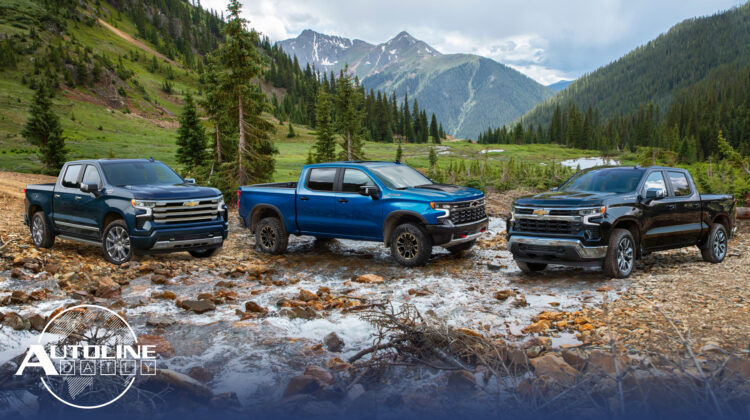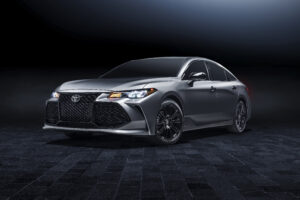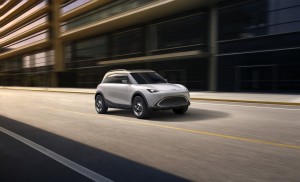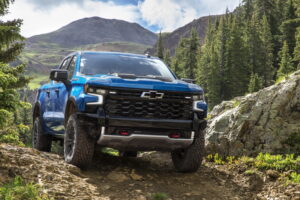
Listen to “AD #3158 – Chevy Silverado Updated; Why OEMs Should Merge ICE Powertrain Operations; smart Reveals Upscale Concept” on Spreaker.
Follow us on social media:
Runtime: 12:13
0:08 Chip Shortage Could Last Another Year
0:29 Toyota Slashes Production Forecast
0:50 Hyundai To Stop Making the Sonata in The U.S.
1:45 Hyundai Designer Now in Charge of Genesis Communications
3:12 Toyota Avalon Nice but Not Spectacular
4:37 smart Reveals Upscale Concept
5:54 Chevy Adds ZR2 To Silverado Lineup
8:31 Why OEMs Should Merge ICE Powertrain Operations
Visit our sponsors to thank them for their support of Autoline Daily: Bridgestone, Intrepid Control Systems, Magna and Schaeffler.
This is Autoline Daily, the show dedicated to enthusiasts of the global automotive industry.
CHIP SHORTAGE COULD LAST ANOTHER YEAR
Don’t expect that chip shortage to get better any time soon. Many analysts expected it to get resolved or get close to normal by the end of the year. But the CEO of Integrated Micro-Electronics, a chip maker based in the Philippines, says the shortage will last at least a year because demand is through the roof.
TOYOTA SLASHES PRODUCTION FORECAST
So it’s no surprise that Toyota is cutting its production forecast by 300,000 units because of the chip shortage and COVID disruptions in Southeast Asia. That’s a pretty significant cut and is the equivalent of taking an entire assembly plant off line for a full year.
HYUNDAI TO STOP MAKING THE SONATA IN THE U.S.
AutoForecast Solutions reports that Hyundai is going to stop making the Sonata at its plant in the U.S. Imported Sonatas from South Korea for the U.S. market are already up about 7,000 units for a 266% increase this year. We reached out to Hyundai Motor Manufacturing of America for a comment and it said, “HMMA will continue to build the Sonata for the foreseeable future.” That plant in Montgomery, Alabama is getting awfully full. It currently makes the Sonata, Elantra, Tucson, Santa Fe and Santa Cruz. Moving the Sonata out of the plant would free up capacity for the CUVs and pickup which have a higher profit margin. We also have got to wonder if Hyundai would move the Elantra out as well. Imports of the Elantra are up 50% this year.
HYUNDAI DESIGNER NOW IN CHARGE OF GENESIS COMMUNICATIONS
It’s not often that a designer breaks out of their role into other areas of the company, which is why we were surprised to see that Luc Donckerwolke, who is the Hyundai Group’s Chief Creative Officer, will also be the Chief Brand Officer for Genesis. So, not only will he be the guy in charge of design, but as head of communications, Donckerwolke can essentially design the image of the brand, which Genesis hopes will increase its awareness and create a consistent and refined brand experience. If the name Luc Donckerwolke is new to you, we’ve reported on him several times in the past as the guy who criticized Lincoln about the Continental looking too much like a Bentley, when he was a top designer at Bentley back in 2015.
TOYOTA AVALON NICE BUT NOT SPECTACULAR
We had the non-hybrid Toyota Avalon come though the Autoline Garage. It’s a nice, conservative car but not the kind of sedan that pulls at your heartstrings. We had the 2.5L four-cylinder engine with an 8-speed automatic and all-wheel-drive. The setup is fine and provides power when you need it but it did feel a bit sluggish and the engine was a little buzzy when you pushed it. The fuel economy is pretty decent for a large all-wheel drive sedan: 28 MPG combined. The exterior styling is very mainstream and the interior design isn’t all that exciting either, but does have a premium feel to it. However, those aren’t really a concern once you get behind the wheel and out on the road. It has a nice comfortable ride. The only thing that disappointed was the 9-inch touchscreen. The hot, humid, muggy weather we drove the Avalon in seemed to slow down the display until the AC cooled down the cabin. The non-hybrid Avalon starts just under $37,000 but the model we drove cost nearly $45,000, including destination charges. People used to joke that the Avalon was the best Buick ever made. But Buick doesn’t make sedans anymore and Toyota is going to follow suit. The Avalon goes out of production next year.
SMART REVEALS UPSCALE CONCEPT
The smart brand is going all electric and it wants to go more upscale. We’d say its newest concept, called the Concept #1, sure looks the part. The small 4-door crossover has a clean minimalistic design, both inside and out. The exterior is highlighted by a floating roof, large trapezoidal grille set low on the bumper and triangular light housings that are connected by a long, thin bar, which is the same front to rear. There really seems to be some influence from Mercedes on the interior that we think is highlighted by the oval vents in the middle of the dash set next to one another. A large, floating screen sits right above the vents and appears, like Tesla, to be the only display for the vehicle. While Concept #1 still feels like a concept without any door handles and featuring big, chunky wheels, smart says it’s a preview of a production model. And you may remember, in March of 2019, Daimler and Geely announced a new joint venture for the smart brand that would see its vehicles assembled in China. This is the first vehicle to come from that. Geely will do the development and engineering, while Mercedes will handle the design.
CHEVY ADDS ZR2 TO SILVERADO LINEUP
The current Chevy Silverado came out in 2019 but it’s already getting a significant refresh. It also gets a ZR2 off-road model for the first time. It shares components from the prototype Silverado ZR2 that’s racing in the Best in the Desert series. That includes the 6.2L V8 that cranks out 420 horsepower and 460 lb-ft of torque. It’s mated to a 10-speed automatic transmission and is available with Terrain Mode, which allows for one-pedal rock climbing. You just take your foot off the accelerator and the truck comes to a stop. Other ZR2 features include Multimatic DSSV spool-valve dampers, off-road chassis and suspension calibrations, plus 33-inch tires. Moving on to the other trims in the lineup, they all get a new front fascia and grille. LT trims and above get a redesigned interior with a new 13.4-inch touchscreen. Super Cruise is now offered and can be used when towing a trailer, however it’s only available for High Country models. Chevy also enhanced the 2.7L turbo four, which delivers 20% more torque and it boosted the towing capacity of the 3.0L Duramax diesel by 4,000 pounds to a total of 13,300 pounds. Pricing for the new Silverado will be revealed closer to when it hits showrooms in the first quarter of 2022.
How long can traditional automakers hang onto their ICE operations? John has something to say about that right after this.
WHY OEMs SHOULD MERGE ICE POWERTRAIN OPERATIONS
The internal combustion engine is in the sunset of its existence. How long it will be around is something we can debate, but with so many countries banning sales of new cars with piston engines within a decade, the end is in sight. Now the question for OEMs is, how do you wind down your traditional powertrain operations?
Volvo Cars is going all electric by 2030. So it spun off its ICE operations, including R&D, engineering, procurement, IT and manufacturing. It formed a joint venture with its parent company Geely which will make ICEs for Geely and whoever else wants to buy them.
In North America, GM, Ford and Stellantis build about 8 million engines and transmissions a year. Roughly 90% of that production overlaps, meaning they’re all building engines with very similar displacements and transmissions with the same number of gears.
Merging their powertrain units would eliminate that duplication and slash costs dramatically. It would create the largest powertrain company in the world that could sell engines and transmissions back to the OEMs at a lower cost than they make in-house.
From a marketing standpoint, it would be relatively easy. The vast majority of American car buyers could not tell you what kind of engine or transmission they have under the hood of their car. Even more importantly, they really don’t care.
There are exceptions. Hard core enthusiasts care deeply about the powertrains in their cars. But they only account for about 10% of car buyers. So the OEMs could keep their performance engines in-house like GM’s LS and LT engines, Chrysler’s Hemi, and Ford’s Coyote.
The best way to do this would be to form a separate company. It couldn’t be done collaboratively because each automaker would be arguing that its engines and transmissions are the best and those arguments would go on for years. This calls for a separate, stand-alone company that can make the hard-nosed decisions of what stays and what goes.
A merger like this would instantly free up cash and resources that could go into electrification, autonomy and connectivity. Wall Street would reward the move because it would take billions of capital off the books. Their stock would jump on the news.
It would work for European and Japanese automakers, too. There’s more of them so they have even more overlap.
I know this is a radical idea, but it only sounds radical today. By the end of this decade, as ICE plant closings become ever more common, radical solutions will start to look like common sense. But why wait until the end of the decade? The savings are ready for the taking right now.
But that’s all for today and this week, thanks for watching and have a great weekend.
Thanks to our partner for embedding Autoline Daily on its website: WardsAuto.com
Seamus and Sean McElroy cover the latest news in the automotive industry for Autoline Daily.










